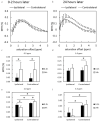Comparison of Chemical Exchange Saturation Transfer Imaging with Diffusion-weighted Imaging and Magnetic Resonance Spectroscopy in a Rat Model of Hypoxic-ischemic Encephalopathy
- PMID: 32009063
- PMCID: PMC7809148
- DOI: 10.2463/mrms.mp.2019-0128
Comparison of Chemical Exchange Saturation Transfer Imaging with Diffusion-weighted Imaging and Magnetic Resonance Spectroscopy in a Rat Model of Hypoxic-ischemic Encephalopathy
Abstract
Purpose: This study aimed to evaluate the effect of chemical exchange saturation transfer (CEST) on the ischemic regions in hypoxic-ischemic encephalopathy (HIE) in comparison with diffusion-weighted imaging (DWI) and magnetic resonance spectroscopy (MRS) using a 7T-MRI.
Methods: We used neonatal rats (n = 8), aged 8 days, to clarify the progression of HIE. The rat model of HIE was developed by ligating and severing the left common carotid artery, followed by 45 minutes of recovery, and 60 minutes of hypoxia (8% O2/92% N2; 34°C). At 0-2 and 24 hours after the onset of HIE, CEST imaging, DWI, and MRS were performed with a 7T-MRI. The magnetization transfer ratio (MTR) asymmetry curves and four MTR asymmetry maps at 0.5, 1.0, 2.0, and 3.5 ppm were calculated using the CEST images. Fractional anisotropy (FA) and apparent diffusion coefficient (ADC) maps were calculated by DWI, and brain metabolites were assessed by MRS.
Results: In the ischemic regions of neonatal rats, FA was significantly increased at 0-2 hours and decreased at 24 hours after the onset of HIE. ADC in the ipsilateral side was significantly lower than that of contralateral side. All rats with HIE showed hypointense areas on MTR asymmetry maps (2.0 and 3.5 ppm), that did not correspond with the hyperintense areas on DWI. In addition, a significant increase in lactate levels was observed at 0-2 and 24 hours after the onset of HIE.
Conclusion: CEST MTR maps did not correspond with the hyperintense areas on DWI at 0-2 and 24 hours after the onset of HIE. The change of multi offset CEST signal may be primarily related to the brain metabolites and pH alterations, such as that caused by lactate, after the onset of HIE.
Keywords: chemical exchange saturation transfer; hypoxic-ischemic encephalopathy; magnetic resonance spectroscopy.
Conflict of interest statement
The authors declare no financial or commercial conflicts of interest.
Figures






Similar articles
-
Early detection of elevated lactate levels in a mitochondrial disease model using chemical exchange saturation transfer (CEST) and magnetic resonance spectroscopy (MRS) at 7T-MRI.Radiol Phys Technol. 2019 Mar;12(1):46-54. doi: 10.1007/s12194-018-0490-1. Epub 2018 Nov 22. Radiol Phys Technol. 2019. PMID: 30467683
-
[Early assessment of severe hypoxic-ischemic encephalopathy in neonates by diffusion-weighted magnetic resonance imaging techniques and its significance].Zhonghua Er Ke Za Zhi. 2007 Nov;45(11):843-7. Zhonghua Er Ke Za Zhi. 2007. PMID: 18282417 Chinese.
-
Diffusion kurtosis imaging and diffusion weighted imaging comparison in diagnosis of early hypoxic-ischemic brain edema.Eur J Med Res. 2023 May 3;28(1):159. doi: 10.1186/s40001-023-01090-x. Eur J Med Res. 2023. PMID: 37131227 Free PMC article.
-
Fifty years of brain imaging in neonatal encephalopathy following perinatal asphyxia.Pediatr Res. 2017 Jan;81(1-2):150-155. doi: 10.1038/pr.2016.195. Epub 2016 Sep 27. Pediatr Res. 2017. PMID: 27673422 Review.
-
Neuroimaging in Neonatal Hypoxic Ischemic Encephalopathy.Indian J Pediatr. 2016 Sep;83(9):995-1002. doi: 10.1007/s12098-016-2042-1. Epub 2016 Feb 24. Indian J Pediatr. 2016. PMID: 26909496 Review.
Cited by
-
Assessment of myelination development in neonatal rats using chemical exchange saturation transfer (CEST) 7-T MRI.Exp Brain Res. 2024 Dec 2;243(1):11. doi: 10.1007/s00221-024-06952-2. Exp Brain Res. 2024. PMID: 39617844
-
Preclinical magnetic resonance imaging and spectroscopy in the fields of radiological technology, medical physics, and radiology.Radiol Phys Technol. 2024 Mar;17(1):47-59. doi: 10.1007/s12194-024-00785-y. Epub 2024 Feb 14. Radiol Phys Technol. 2024. PMID: 38351261 Free PMC article. Review.
-
Amide proton transfer and apparent diffusion coefficient analysis reveal susceptibility of brain regions to neonatal hypoxic-ischemic encephalopathy.Heliyon. 2024 Sep 19;10(18):e38062. doi: 10.1016/j.heliyon.2024.e38062. eCollection 2024 Sep 30. Heliyon. 2024. PMID: 39347396 Free PMC article.
-
Creatine Chemical Exchange Saturation Transfer (Cr-CEST) Imaging Can Evaluate Cisplatin-induced Testicular Damage.Magn Reson Med Sci. 2023 Jul 1;22(3):345-351. doi: 10.2463/mrms.mp.2021-0125. Epub 2022 May 10. Magn Reson Med Sci. 2023. PMID: 35545506 Free PMC article.
-
Application of Magnetic Resonance Strain Analysis Using Feature Tracking in a Myocardial Infarction Model.Tomography. 2023 Apr 18;9(2):871-882. doi: 10.3390/tomography9020071. Tomography. 2023. PMID: 37104142 Free PMC article.
References
-
- Douglas-Escobar M, Weiss MD. Hypoxic-ischemic encephalopathy: a review for the clinician. JAMA Pediatr 2015; 169:397–403. - PubMed
-
- Ferriero DM. Neonatal brain injury. N Engl J Med 2004; 351:1985–1995. - PubMed
-
- Kumral A, Ozer E, Yilmaz O, et al. Neuroprotective effect of erythropoietin on hypoxic-ischemic brain injury in neonatal rats. Biol Neonate 2003; 83:224–228. - PubMed

